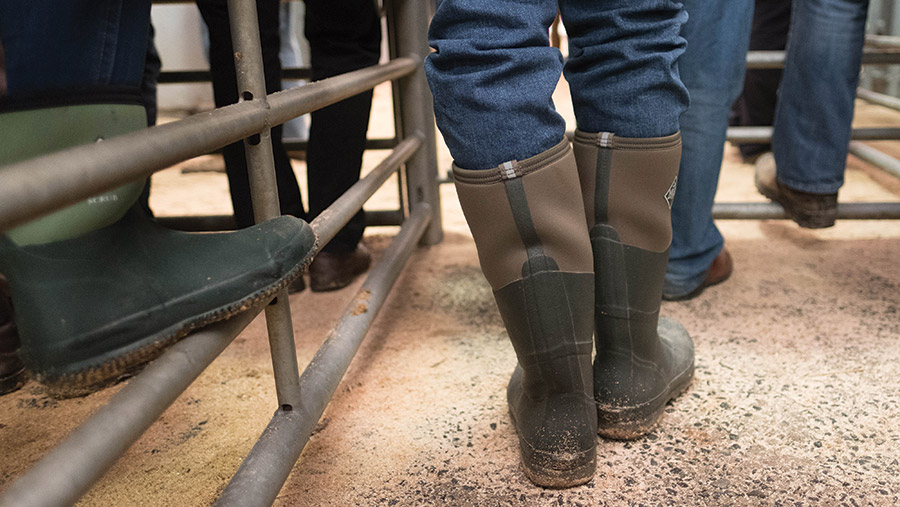Advice on solving farmer lameness, joint and foot ailments
 © Tim Scrivener
© Tim Scrivener A hobble is an unwelcome rite of passage for many farmers as they transition from youth to older-middle age, but just as lameness is preventable in livestock so too is it in the men and women who lavish care on the hooves of their animals.
The main culprit for the joint and foot problems that inflict pain and misery on farmers is the wellington boot and the many hours they spend trudging around in them.
Then there is the nature of farm work, says Jeroen Bruins, a physiotherapist who practices in rural Pembrokeshire.
See also: Video: How farmers can improve their mobility to avoid injury
During his 24 years of helping those in pain and discomfort, many of his patients have been working farmers or those who have retired from the industry who present with foot or foot-related injuries and disorders.
“The farming industry is notorious for working long hours in all sorts of conditions, on any ground surface and in any position, and this often requires prolonged periods of loading on the feet as well as other lower and upper limbs, pelvic and spinal parts of the body,’’ says Mr Bruins, of Physiofit West Wales.
This, he warns, has the potential to increase the risk of common foot and ankle injuries.
If ignored, these can lead to chronic pain, discomfort and, in some cases, deformity.
“We often see that chronic foot injuries and deformity have contributed greatly to the wear and tear of knee and hip joints in later life,’’ says Mr Bruins.
Treatable aliments
But the good news is that just as lameness is preventable in livestock, so too is it in farmers.
Wearing suitable footwear that accommodate the feet in the best position and which absorb the forces equally throughout the feet will give the correct support and safety for the feet and ankle joints, Mr Bruins advises.
“Each foot consists of 26 bones, 33 joints, 107 ligaments and 19 muscles and are the foundation of the body when weight bearing, therefore, correct support is important to avoid further unnecessary strain on knees, hips and the lower back.’’
See also: Visit FW’s Health and Wellbeing Hub for more advice
The new generation of farmers are benefiting from huge improvements to farm footwear and this has resulted in a noticeable reduction in the foot and ankle-related injuries and disorders that their parents endured.
“I would certainly recommend investing in a good variety of footwear, suited to different types of farm work and to different work surfaces,’’ says Mr Bruins.
“It is as important as investing in good machinery to maintaining a healthy productivity and to preventing unnecessary discomfort, treatments or even absenteeism.’’
Advice for welly wearers
Replace boots when they are worn out and feet no longer feel supported – once this happens, feet will start incurring damage.
The ideal boot should have a supportive foot bed and a cushioned heel, which helps to support the arch of the foot.
Support under the big toe is preferable, too, as a lack of support here can result in lower back pain.
Common foot injuries associated with farming and how to prevent them
Plantar fasciitis
This inflammation of the connective tissue at the bottom of the foot, which supports the arch, can be caused by repetitive loading or running, having a natural high arch or tight calf muscles.
Sufficient arch support and calf stretching can prevent or reduce the discomfort from an irritated plantar fascia.
Achilles tendinitis
An inflammation of the tendon of the calf muscles attached to the heel bone which, like plantar fasciitis, can be caused by very tight calf muscles.
Due to excessive loading by farmers, hill farmers in particular, this is not uncommon in farming.
Mr Bruins recommends the same preventative strategies as for plantar fasciitis.
A heel spur
This is an excessive bone growth that forms on top of normal bone and is more often seen in people with flat feet – those with no heel arch – and can be a result of wearing inadequate footwear.
As heel spurs can be initiated during childhood, parents are advised to make sure that their children’s wellington boots have suitable support, those that hold the joints of the foot in a good bio-mechanical position.
Other risk factors are tight ligaments, arthritis, excess body weight and excessive walking or combinations of these, many of which can be prevented.
Ankle sprains and strains
These happen when the ankle twists inwards or outwards, leading to trauma to ligaments and muscle or tendon fibres.
This is caused by intricate footwork, often on uneven surfaces or by sudden changing in direction.
This is a common injury in farming because working conditions often involve uneven surfaces.
The better the foot is supported, the less this is likely to happen, says Mr Bruins.
Bunions
These are caused by wearing footwear that is too tight or too narrow. In most cases, these can be prevented with appropriate and well-fitting footwear.
Other common conditions
Mr Bruins says other common foot and ankle conditions common among farmers are corns, stress fractures, stone bruises, claw toes, neuromas, shin splints, calf sprains, osteochondritis and arthritis.
Wellies keep the moisture out but they can also make feet sweat and this can lead to other conditions such as athlete’s foot or fungal nail infections.
Daily foot hygiene, suitable socks and, where possible, dry footwear will help keep feet in optimum condition.
“Some foot conditions require medical attention but the majority are perfectly treatable by a GP or a qualified and registered podiatrist, physiotherapist, chiropodist or sport therapist,’’ says Mr Bruins.
Britain’s Fittest Farmer 2020
It’s quick and easy to apply – just go the the website, fill in the application form and upload a video or photo of yourself and tell us which of the three qualifiers you’ll compete at.
These are free events for the rural community to take part in or spectate as competitors tackle a series of physically challenges designed to test all elements of fitness, set by judge Tom Kemp.
Remember, this competition is all about finding great ambassadors for physical fitness and mental health in agriculture, so it’s about more than who can run the fastest half-marathon or lift the heaviest tractor tyre.
Our sponsor and partners
Grenadier: Sponsor

Tough, rugged, agile – the new INEOS Grenadier 4X4 will share plenty of traits exhibited by the winner of Britain’s Fittest Farmer. That’s why we’re so pleased to be sponsoring this rural British physical challenge.
As an uncompromising, no frills, off-road vehicle, the Grenadier will provide all the capability, durability and reliability you need to tackle the toughest tasks on the farm. That’s why we see ourselves as the ideal partner for this true test of grit, endurance and strength.
For more information on Grenadier, pay a visit to their website.
Farm Fitness: Partner

Farm Fitness has rapidly become a burning beacon on the UK fitness scene, attracting spectators and participants from all over the country to come and take a swing at its almost alchemic blend of modified strongman, functional bodybuilding, calisthenics and blistering cardio efforts.
The gym, founded by farmer’s son Tom Kemp, was voted one of the best gyms in the world and ‘coolest outdoor space’ by Men’s Health (PDF)
Tom has blended his farming background with his love of training to create a raw and exciting outdoor environment for people of all strengths and abilities to get fit.
The Farming Community Network: Partner

The Farming Community Network (FCN) is a voluntary organisation and charity that supports farmers and families within the farming community through difficult times.
The charity has helped thousands of people deal with a variety of issues, including financial difficulties, animal disease, mental health and family disputes.
Volunteers provide free, confidential, pastoral and practical support to anyone who seeks help, regardless of whether the issue is personal or business-related. FCN also runs a confidential national helpline and e-helpline.
